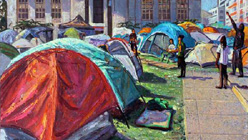Artists often offer accounts of social issues that become a matter of record for history. Their clear gaze can bring the unfiltered truth into focus. This sort of social accounting is a long tradition across media but is especially true of drawing and painting. Consider Goya’s etching series The Disasters of War (1810-1820), images from the French-Spanish war of the early 1800s, or Pablo Picasso’s Guernica (1937), depicting the bombing of a Basque Country village. More recently, contemporary artist Fernando Botero created a radical suite of works on the atrocities of Abu Ghraib, sending askew common perceptions of his kitschy rotund figures with the indictment of torture.
Occupy: The Plein Air Story offers multiple accounts of the peaceful international movement instigated by Occupy Wall Street last year — and the works, created in-situ, provide a dramatic counterpoint to images of violence favored in the media. Local artists Anthony Holdsworth, Jessica Jirsa, John Paul Marcelo, Rick Rocamora, and Tomye situated themselves within the San Francisco and Oakland Occupy encampments to record the activities with conventional painting, photography, and video. The results are more sincere than sentimental, and formally beautiful while evoking larger questions around the badly quashed Occupy movement: Why were such peaceful scenes met with the aggressive force portrayed on the evening news? While much of the country saw chaos in the Occupy movement, many artists saw astonishing moments of grace.

John Paul Marcelo, General Assembly in the Sunlight, 2011.
While artists are capable of shining a light on violence throughout history, there are also times when artists counter accounts of violence with a truer representation of peaceful demonstrations maligned in the media. Occupy: The Plein Air Story, curated by Eric Murphy at Oakland’s Joyce Gordon Gallery, offers perspectives on what the movement looked like from within the simultaneously messy and generous Bay Area utopian encampments. Though many still parse the unfocused goals of the Occupy Movement, this query has seen a reply in the rapid mobilization of the New York Occupy community around post-Sandy disaster efforts, often reported as stronger in numbers and more nimble than the Red Cross. How the local Occupy community will resonate in the future has yet to be determined. At present, what remains are impressions of a movement that followed in a long tradition of grass roots resistance, more powerful than anything in recent memory.

Jessica Jirsa, The Sit In 1/6/12, 2012.
Realist oil painter Anthony Holdsworth, a regular figure at work around the East Bay, presents a sunny vision of the tents that proliferated on the grounds in front of Oakland City Hall. Truthfully, the East Bay does offer the kind of light-filled landscape that borders on saccharine in realist representations — locals don’t call it the sunny side of the Bay for nothing. In Holdsworth’s images, figures are scattered within the compositions, standing in dialogue or sitting along stone steps. The regular resources organized within the camp aren’t explicitly represented — a free, open kitchen stocked with an abundance of donations, medical treatment tents, art workshops for children and a well-stocked public library; all organized on an honor system — but the atmosphere of community is evident.




